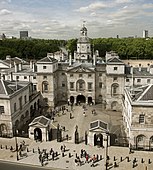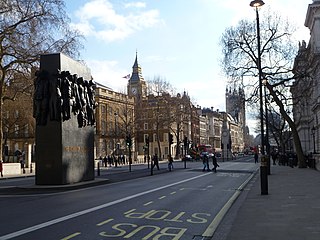
Whitehall is a road and area in the City of Westminster, Central London, England. The road forms the first part of the A3212 road from Trafalgar Square to Chelsea. It is the main thoroughfare running south from Trafalgar Square towards Parliament Square. The street is recognised as the centre of the Government of the United Kingdom and is lined with numerous departments and ministries, including the Ministry of Defence, Horse Guards and the Cabinet Office. Consequently, the name "Whitehall" is used as a metonym for the British civil service and government, and as the geographic name for the surrounding area.
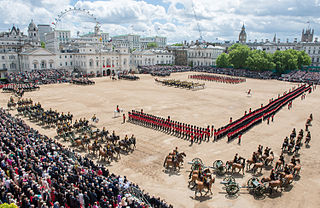
Trooping the Colour is a ceremonial event performed every year on Horse Guards Parade in London, United Kingdom, by regiments of Household Division, to celebrate the official birthday of the British sovereign. It is also known as the Sovereign's Birthday Parade. Similar events are held in other countries of the Commonwealth. In the UK, it is, with the State Opening of Parliament, one of the biggest events of the ceremonial calendar, and watched by millions on TV and on the streets of London.

The Royal Regiment of Horse Guards (The Blues) (RHG) was a cavalry regiment of the British Army, part of the Household Cavalry.
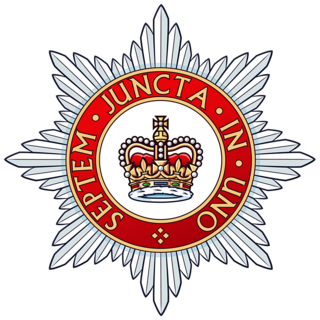
The Household Division forms a part of the British Army's London District and is made up of five regiments of foot guards and two Household Cavalry regiments. The division is responsible for performing public duties and state ceremonies in London and Windsor. Such functions include the State Opening of Parliament, Trooping the Colour, and mounting the King's Guard.

Horse Guards Parade is a large parade ground off Whitehall in central London. It is the site of the annual ceremonies of Trooping the Colour, which commemorates the monarch's official birthday, and the Beating Retreat.
The Household Cavalry (HCav) is made up of the two most senior regiments of the British Army, The Life Guards and The Blues and Royals. These regiments are divided between the Household Cavalry Regiment stationed at Wing Barracks in Wiltshire and the ceremonial mounted unit, the Household Cavalry Mounted Regiment, garrisoned at Hyde Park Barracks in London. The Household Cavalry is part of the Household Division and is the King's official bodyguard. Although the Household Cavalry Regiment is armoured, it is not part of the Royal Armoured Corps.

Guard mounting, changing the guard, or the changing of the guard, is a formal ceremony in which sentries performing ceremonial guard duties at important institutions are relieved by a new batch of sentries. The ceremonies are often elaborate and precisely choreographed. They originated with peacetime and battlefield military drills introduced to enhance unit cohesion and effectiveness in the late 17th and early 18th centuries.
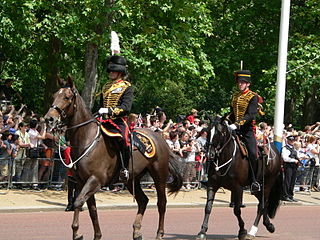
The King's Troop, Royal Horse Artillery, is a ceremonial unit of the British Army, quartered at Woolwich. It is a mounted unit and all of its soldiers are trained to care for and drive teams of six horses, each team pulling a First World War-era QF 13-pounder gun; six teams are used in the unit's Musical Drive. The Troop's duties include firing salutes on royal and state occasions, participation in parades, and the duties of the King's Life Guard at Horse Guards for one month each year. The unit provides the gun carriage and team of black horses for state funerals. The unit is most often seen providing gun salutes on state occasions in Hyde Park, and Green Park.
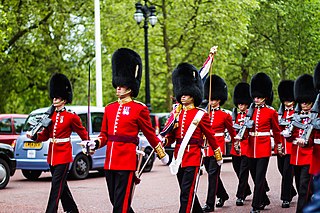
The King's Guard are sentry postings at Buckingham Palace and St James's Palace, organised by the British Army's Household Division. The Household Division also mounts sentry postings at Horse Guards, known as the King's Life Guard.
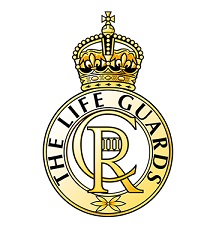
TheLife Guards (LG) is the most senior regiment of the British Army and part of the Household Cavalry, along with The Blues and Royals.
Horse Guards or horse guards can refer to:

The Royal Horse Artillery (RHA) was formed in 1793 as a distinct arm of the Royal Regiment of Artillery to provide horse artillery support to the cavalry units of the British Army. Although the cavalry link remained part of its defining character, as early as the Battle of Waterloo the RHA was sometimes deployed more along the lines of conventional field artillery, fighting from comparatively fixed positions.

Public duties are performed by military personnel, and usually have a ceremonial or historic significance rather than an overtly operational role.
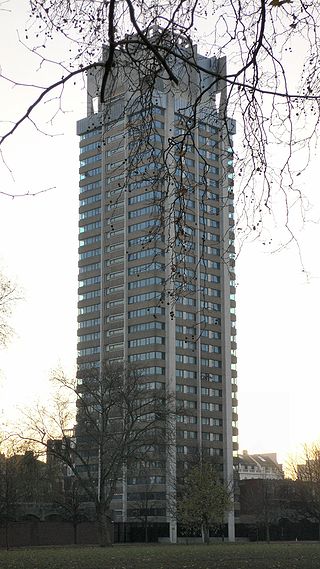
The Hyde Park Barracks are in Knightsbridge in central London, on the southern edge of Hyde Park. They were often known as Knightsbridge Barracks and this name is still sometimes used informally. The barracks are 3⁄4 mile (1.2 km) from Buckingham Palace, enabling the officers and soldiers of the Household Cavalry to be available to respond speedily to any emergency at the Palace, practice drills at Horse Guards Parade or beyond and conduct other more ceremonial duties.
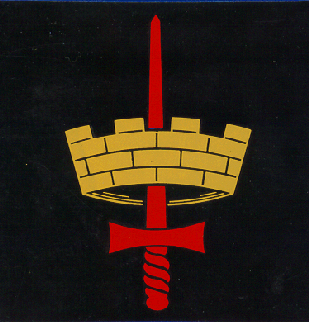
London District (LONDIST) is the name given by the British Army to the area of operations encompassing the Greater London area. It was established in 1870 as Home District.
The Household Cavalry Mounted Regiment (HCMR) is a cavalry regiment of the British Army tasked primarily with ceremonial duties. Part of the Household Division, it is classed as a regiment of guards, and carries out mounted ceremonial duties on State and Royal occasions. The HCMR is one of two operational units that form the Household Cavalry (HCav), the other being the Household Cavalry Regiment (HCR), a formation reconnaissance regiment, with front-line combat duties.

The Horse Grenadier Guards, usually referred to as Horse Grenadiers, were a series of cavalry troops in the British Household Cavalry between 1687 and 1788, who used grenades and other explosives in battle. Originally attached to the Horse Guards, they became independent for a century before being disbanded. However, the men of the troops formed the basis of the new troops of Life Guards.
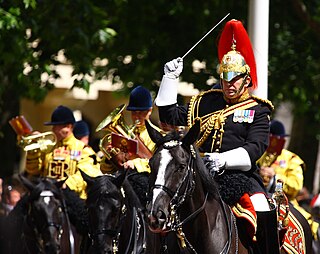
The Mounted Band of the Household Cavalry is a British Army band which ceremonially serves the Household Cavalry Mounted Regiment (HCMR). The HCMR Band is the largest symphonic wind band in the British Army. It is one of the bands of the Royal Corps of Army Music (RCAM) and is currently based at Hyde Park Barracks and Combermere Barracks.
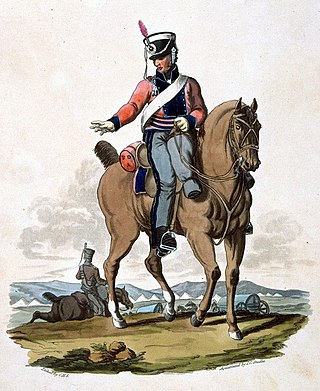
The Cavalry Staff Corps was a unit formed during the Napoleonic Wars to keep discipline in the British Army. Consisting of four troops of cavalry, the corps was first raised in 1813 during the Peninsular War to deal with an excess of criminality and desertion in the Duke of Wellington's armies. It was disbanded after that campaign ended in 1814 but was reformed in 1815 during the Hundred Days campaign. The corps also served in the subsequent occupation of France. The unit was Britain's first standing military police force. A successor unit was raised for service in the Crimean War of 1853–1856 and a permanent military police was established in 1877.

The 2022 Trooping the Colour ceremony was held on Thursday 2 June 2022, as part of the Platinum Jubilee celebrations of Queen Elizabeth II. Over 1,400 parading soldiers, 200 horses, and 400 musicians came together in the traditional parade to mark the Queen's Official Birthday, which usually takes place on the second Saturday of June. It was the final Birthday Parade to take place under the reign of Elizabeth II before her death on 8 September later that year.







